Norwegian Cruise Line Holdings Bundle
How Did Norwegian Cruise Line Become a Cruise Industry Giant?
Embark on a journey through time to uncover the fascinating Norwegian Cruise Line Holdings SWOT Analysis and its remarkable transformation. From its inception as Norwegian Caribbean Lines in 1966, this cruise line has redefined the travel industry. Discover how Norwegian Cruise Line history has shaped the landscape of modern cruising, influencing how we experience the open sea.
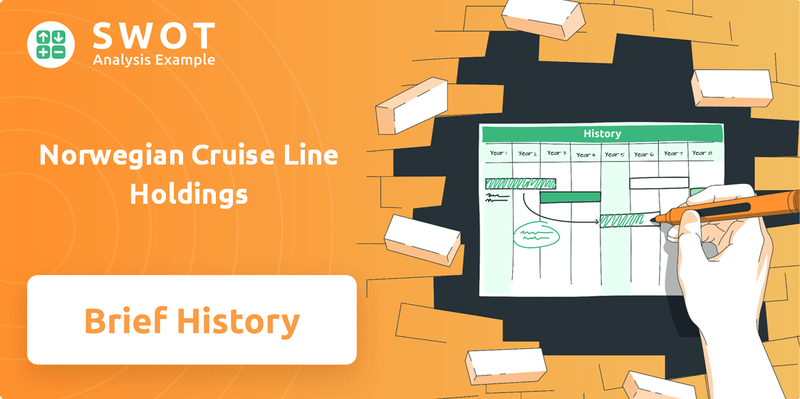
This brief overview of Norwegian Cruise Line explores key milestones, from its early years to its current status as a leading operator. Understanding history of cruise ships is essential for investors and industry watchers alike. Learn about the evolution of NCLH, including its fleet development and strategic adaptations to changing travel trends.
What is the Norwegian Cruise Line Holdings Founding Story?
The story of Norwegian Cruise Line Holdings (NCLH) begins in December 1966. It started with Norwegian Caribbean Lines, a venture by Knut Kloster, a Norwegian shipping magnate, and Ted Arison, later of Carnival Cruise Line. Their vision was to tap into the growing demand for accessible, leisure-focused cruises in the Caribbean, a shift from the more formal ocean liner experiences of the time.
This marked the genesis of what would become a major player in the cruise line industry. The founders aimed to provide a more relaxed and affordable cruising experience. This approach helped lay the groundwork for the modern cruise industry we know today.
The initial business model focused on shorter, casual cruises in the Caribbean. The first ship, the M/S Sunward, was a converted car ferry, starting sailings in December 1966. Funding came from Kloster's family shipping business, Kloster Rederi A/S.
- The name 'Norwegian Caribbean Lines' directly reflected the founders' heritage and operating area.
- Kloster's shipping expertise and Arison's entrepreneurial spirit were key.
- The 1960s' economic climate, with increased leisure time, supported the cruise industry's growth.
- The company's early years were marked by innovation in the travel industry.
The founding team's combined expertise was critical. Kloster brought his deep knowledge of shipping, while Arison provided entrepreneurial drive. The economic and cultural shifts of the 1960s, with more free time and disposable income in North America, created a favorable environment for the growth of the cruise industry. This early focus on accessibility and casual cruising set the stage for the evolution of Norwegian Cruise Line Holdings' business model.
Norwegian Cruise Line Holdings SWOT Analysis
- Complete SWOT Breakdown
- Fully Customizable
- Editable in Excel & Word
- Professional Formatting
- Investor-Ready Format
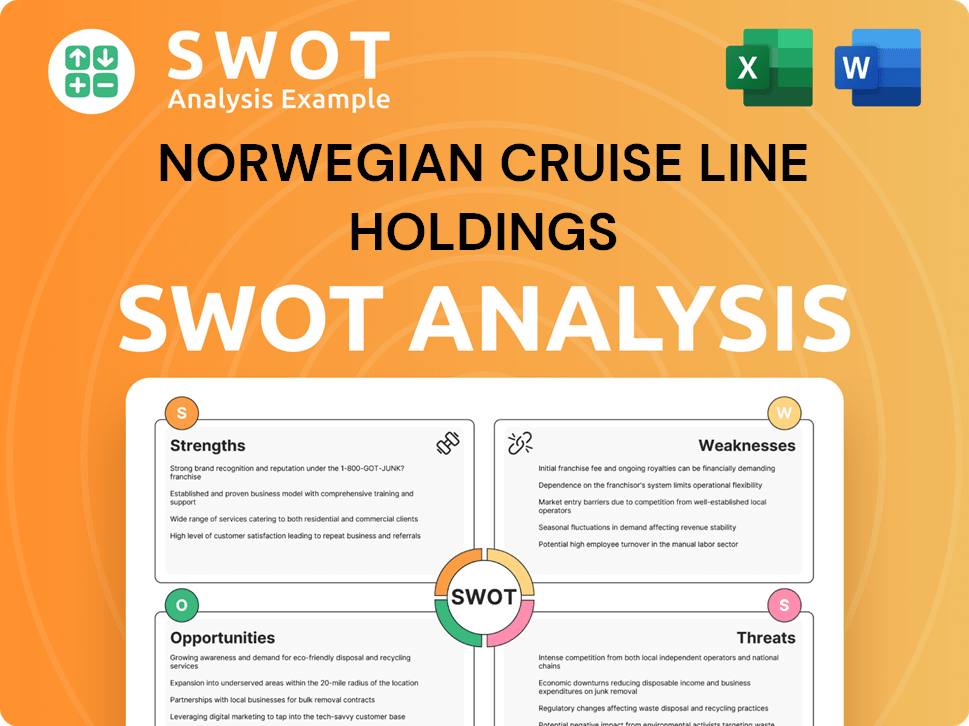
What Drove the Early Growth of Norwegian Cruise Line Holdings?
The early years of Norwegian Cruise Line (NCL), a key player in the Marketing Strategy of Norwegian Cruise Line Holdings, were marked by rapid growth and strategic innovations. Initially known as Norwegian Caribbean Lines, the company quickly gained a foothold in the travel industry by offering a relaxed atmosphere and destination-rich itineraries. This period saw the expansion of its fleet and the introduction of pioneering concepts that would shape its future.
In the late 1960s and early 1970s, Norwegian Caribbean Lines added several purpose-built cruise ships to its fleet, including the Starward, Skyward, and Southward. These additions increased passenger capacity and expanded the range of itineraries offered. A significant milestone was the acquisition and transformation of the SS France into the SS Norway in 1979, which was the largest cruise ship in the world at that time, significantly boosting NCL's profile.
NCL's early customer acquisition strategies focused on partnerships with travel agents and direct marketing efforts. The company highlighted its unique, relaxed cruise experience to attract customers. In 1977, NCL introduced Great Stirrup Cay, the industry's first private island destination. Leadership transitions included Ted Arison's departure to form Carnival Cruise Line, with Knut Kloster leading NCL's growth.
Throughout the 1980s, Norwegian Cruise Line, as it became known, continued to expand its fleet and introduce innovative concepts. The company adapted to the competitive landscape by enhancing onboard offerings and extending its reach beyond the Caribbean to destinations like Alaska and Europe. By the late 1980s and early 1990s, NCL had established itself as a significant player in the contemporary cruise market.
NCL made pivotal decisions to invest in larger, more modern ships during this period, solidifying its brand identity around freedom and flexibility. These strategic moves set the stage for its 'Freestyle Cruising' innovation. In 2024, the cruise industry is projected to continue its recovery, with NCLH poised to benefit from increased demand and operational efficiencies. The company's focus on innovation and customer experience remains central to its long-term strategy.
Norwegian Cruise Line Holdings PESTLE Analysis
- Covers All 6 PESTLE Categories
- No Research Needed – Save Hours of Work
- Built by Experts, Trusted by Consultants
- Instant Download, Ready to Use
- 100% Editable, Fully Customizable
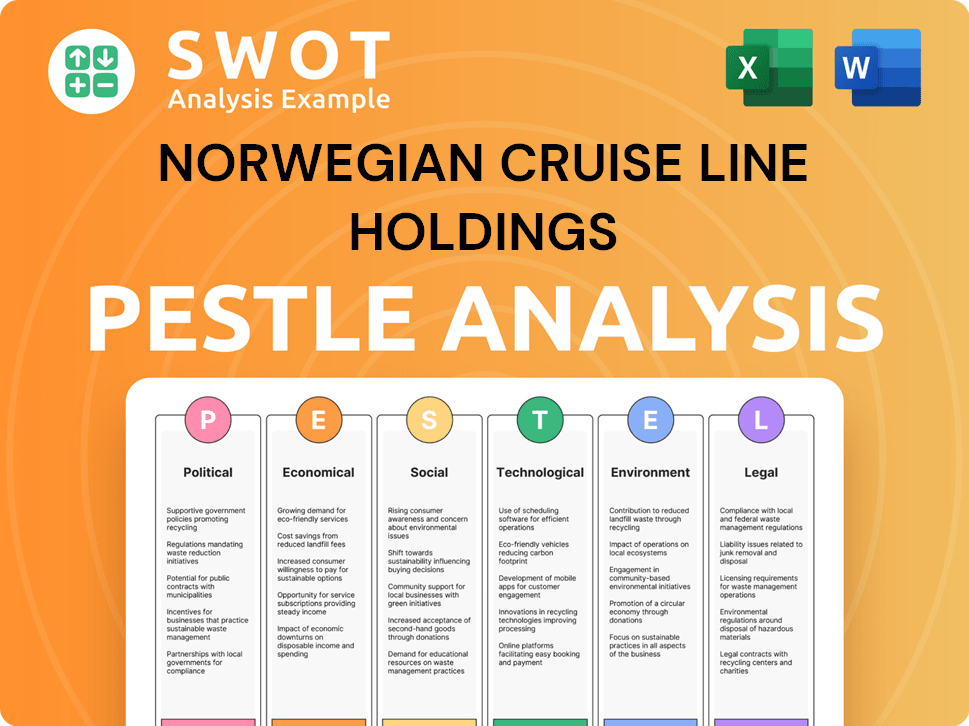
What are the key Milestones in Norwegian Cruise Line Holdings history?
The story of Norwegian Cruise Line Holdings, or NCLH, is marked by significant milestones and strategic shifts within the travel industry. From its early years to its current position, the company has navigated various challenges and celebrated numerous achievements, shaping its identity as a prominent cruise line.
| Year | Milestone |
|---|---|
| 2000 | Introduction of 'Freestyle Cruising,' revolutionizing the industry with flexible dining and dress codes. |
| 2014 | Acquisition of Prestige Cruise Holdings, expanding the portfolio to include Oceania Cruises and Regent Seven Seas Cruises. |
| 2020 | The COVID-19 pandemic led to a complete halt in operations, requiring significant financial restructuring. |
| 2023 | NCLH reported a $6.1 billion revenue, demonstrating a strong recovery from the pandemic. |
Innovations have been central to the growth of NCLH. The company consistently introduced new concepts to enhance the passenger experience and maintain its competitive edge in the cruise line market.
This innovation, introduced in 2000, offered passengers unprecedented flexibility in dining and dress code, setting a new standard in the travel industry.
These larger ships featured diverse dining options, entertainment venues, and onboard activities, enhancing the overall cruise experience. This fleet expansion increased capacity and appeal.
Efforts to reduce carbon footprint and improve waste management reflect a commitment to sustainability. The company has invested in technologies to reduce emissions and waste.
Despite these advancements, NCLH has faced several challenges, particularly economic downturns and the COVID-19 pandemic. The cruise line had to adapt to changing market conditions and consumer behavior.
Economic crises, such as the 2008 financial crisis, impacted consumer spending on leisure travel, leading to decreased demand. These downturns required strategic financial planning and cost management.
The pandemic brought the entire cruise industry to a standstill in 2020, causing significant financial losses. In May 2020, NCLH raised approximately $2.4 billion to bolster its financial position.
Adapting to evolving travel restrictions and consumer confidence was crucial during the pandemic. The company focused on enhanced health and safety protocols to ensure a safe return to service.
Norwegian Cruise Line Holdings Business Model Canvas
- Complete 9-Block Business Model Canvas
- Effortlessly Communicate Your Business Strategy
- Investor-Ready BMC Format
- 100% Editable and Customizable
- Clear and Structured Layout
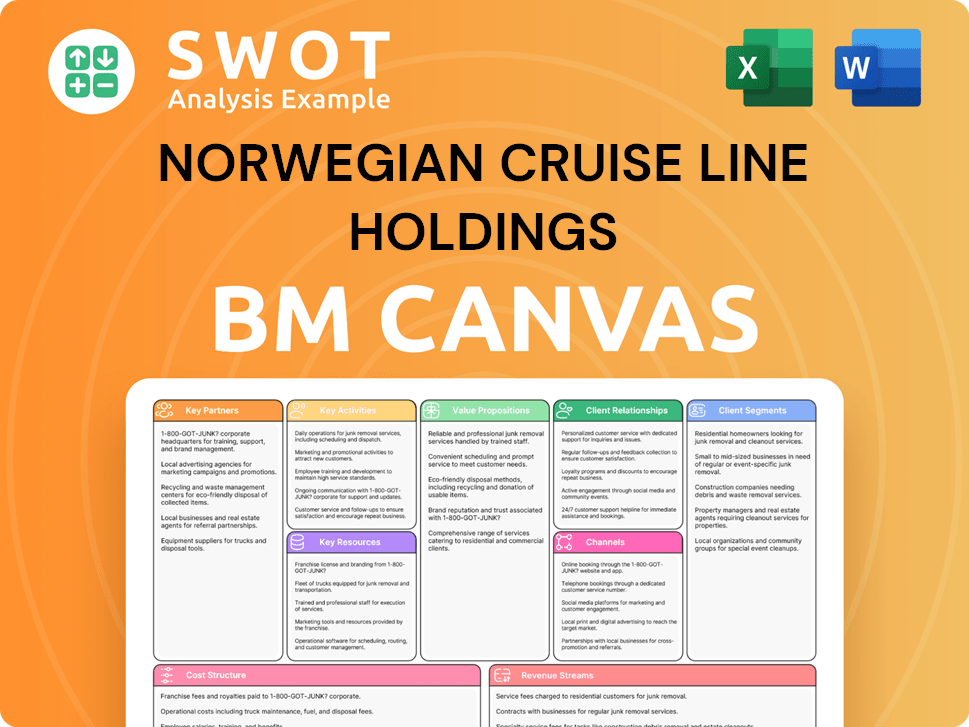
What is the Timeline of Key Events for Norwegian Cruise Line Holdings?
The Owners & Shareholders of Norwegian Cruise Line Holdings, formerly known as Norwegian Caribbean Lines, has a rich history marked by innovation and strategic expansions in the travel industry. Founded in 1966, the cruise line quickly established itself as a key player in the cruise line sector. Over the years, it has navigated significant milestones, from pioneering private islands to adapting to global crises, solidifying its position in the market.
| Year | Key Event |
|---|---|
| 1966 | Founded as Norwegian Caribbean Lines, marking the beginning of its journey. |
| 1977 | Acquired Great Stirrup Cay, becoming the first in the industry to own a private island. |
| 1979 | Acquired the SS France, which was later transformed into the SS Norway. |
| 1987 | Renamed to Norwegian Cruise Line, reflecting its evolving brand identity. |
| 2000 | Introduced 'Freestyle Cruising,' a concept that redefined the cruise experience. |
| 2013 | Completed its initial public offering (IPO) on the NASDAQ under the ticker NCLH. |
| 2014 | Acquired Prestige Cruise Holdings, expanding its portfolio with Oceania Cruises and Regent Seven Seas Cruises. |
| 2020-2021 | Faced significant operational challenges due to the COVID-19 pandemic. |
| 2022 | Resumed full fleet operations post-pandemic, signaling a recovery. |
| 2023 | Reported strong financial results, indicating a robust recovery. |
| 2024 | Continued fleet modernization and expansion with new ship deliveries. |
| 2025 | Expected delivery of new Prima Class ships, enhancing capacity and guest experience. |
The company is focused on expanding and modernizing its fleet. New ships are planned across all three brands, including additional Prima Class ships for Norwegian Cruise Line. This expansion is designed to increase capacity and introduce new onboard experiences, catering to evolving traveler preferences.
NCLH is actively optimizing its global itineraries. The company is exploring new destinations and expanding its presence in key international markets. The goal is to offer diverse and appealing cruise options to attract a broader customer base and capitalize on emerging travel trends.
The company plans to leverage technology to enhance the guest experience. This includes streamlining operations and improving sustainability efforts. These initiatives aim to improve efficiency and reduce environmental impact, aligning with the growing demand for responsible travel.
The future outlook for Norwegian Cruise Line and the broader cruise industry involves a focus on experiential travel and sustainable practices. NCLH aims to capitalize on these trends, aiming for sustained financial performance and market leadership. The company's strategy includes continuous innovation.
Norwegian Cruise Line Holdings Porter's Five Forces Analysis
- Covers All 5 Competitive Forces in Detail
- Structured for Consultants, Students, and Founders
- 100% Editable in Microsoft Word & Excel
- Instant Digital Download – Use Immediately
- Compatible with Mac & PC – Fully Unlocked
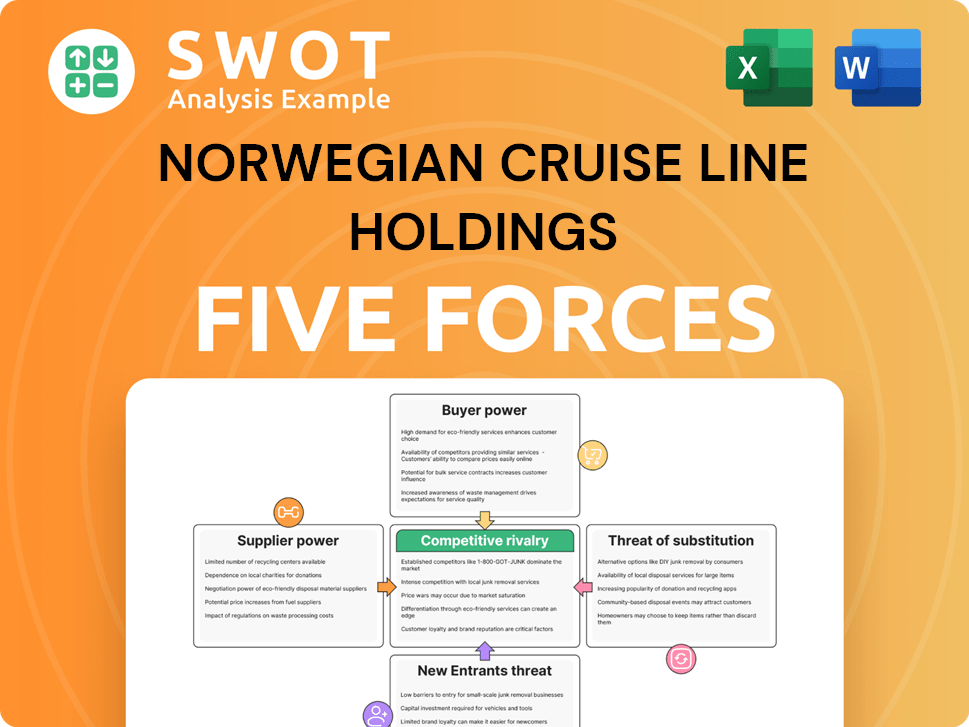
Related Blogs
- What is Competitive Landscape of Norwegian Cruise Line Holdings Company?
- What is Growth Strategy and Future Prospects of Norwegian Cruise Line Holdings Company?
- How Does Norwegian Cruise Line Holdings Company Work?
- What is Sales and Marketing Strategy of Norwegian Cruise Line Holdings Company?
- What is Brief History of Norwegian Cruise Line Holdings Company?
- Who Owns Norwegian Cruise Line Holdings Company?
- What is Customer Demographics and Target Market of Norwegian Cruise Line Holdings Company?
Disclaimer
All information, articles, and product details provided on this website are for general informational and educational purposes only. We do not claim any ownership over, nor do we intend to infringe upon, any trademarks, copyrights, logos, brand names, or other intellectual property mentioned or depicted on this site. Such intellectual property remains the property of its respective owners, and any references here are made solely for identification or informational purposes, without implying any affiliation, endorsement, or partnership.
We make no representations or warranties, express or implied, regarding the accuracy, completeness, or suitability of any content or products presented. Nothing on this website should be construed as legal, tax, investment, financial, medical, or other professional advice. In addition, no part of this site—including articles or product references—constitutes a solicitation, recommendation, endorsement, advertisement, or offer to buy or sell any securities, franchises, or other financial instruments, particularly in jurisdictions where such activity would be unlawful.
All content is of a general nature and may not address the specific circumstances of any individual or entity. It is not a substitute for professional advice or services. Any actions you take based on the information provided here are strictly at your own risk. You accept full responsibility for any decisions or outcomes arising from your use of this website and agree to release us from any liability in connection with your use of, or reliance upon, the content or products found herein.